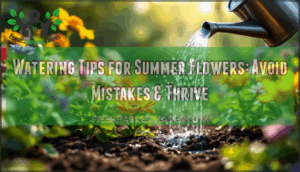This site is supported by our readers. We may earn a commission, at no cost to you, if you purchase through links.
 Your tomato plants looked perfect yesterday morning. By evening, half their leaves had vanished, leaving behind nothing but stems and a trail of dark green droppings. If you’ve found yourself racing against hungry caterpillars this summer, you’re not alone—these voracious larvae can strip a healthy plant bare in just days during peak growing season.
Your tomato plants looked perfect yesterday morning. By evening, half their leaves had vanished, leaving behind nothing but stems and a trail of dark green droppings. If you’ve found yourself racing against hungry caterpillars this summer, you’re not alone—these voracious larvae can strip a healthy plant bare in just days during peak growing season.
The challenge isn’t just spotting the damage; it’s knowing which control method actually works without harming your beneficial insects or next week’s harvest. From hand-picking techniques that target specific pests to organic sprays proven to reduce damage by 80%, effective caterpillar management starts with understanding what you’re dealing with and acting before minor leaf nibbling becomes a full-scale invasion.
Table Of Contents
Key Takeaways
- Early detection and regular hand-picking every few days can reduce caterpillar populations by over 65% and prevent major damage.
- Organic controls like neem oil and Bacillus thuringiensis (Bt) sprays target caterpillars effectively while protecting pollinators and edible crops.
- Physical barriers such as mesh netting and row covers can cut infestation rates by up to 88%, especially for vulnerable vegetable beds.
- Attracting birds and beneficial insects through native plantings and companion crops creates a natural defense system that keeps caterpillar pressure low all season.
Identifying Caterpillar Damage in Summer Gardens
Spotting caterpillar damage early can save your garden from serious harm. The telltale signs aren’t always obvious at first glance, but once you know what to look for, you’ll recognize them quickly.
Let’s walk through the common indicators, the types of caterpillars you’re likely to encounter, and which plants face the greatest risk.
Common Signs of Caterpillar Infestations
You’ll spot caterpillar infestation through several telltale signs. Look for leaf damage with ragged holes and garden pests leaving frass—tiny dark pellets—beneath plants. Rolled leaves bound with silk, missing flower buds, and stripped stems indicate active caterpillar damage.
Since many feed nocturnally, check your garden at night with a flashlight for a definitive caterpillar control diagnosis. Regular garden inspections can help identify signs of caterpillar damage early on.
Types of Caterpillars Found in Gardens
Different caterpillar species target specific plants in your garden. Hornworms—both tomato and tobacco hornworm types—can strip tomato foliage overnight, reaching up to 4 inches long. Cabbage loopers loop across brassicas like kale and broccoli. Cutworms sever seedlings at soil level after dark. Tent caterpillars build silken nests in trees, while leaf eaters like armyworms cause widespread damage across multiple crops.
Gardeners should be aware of milkweed plant preferences to manage caterpillar populations effectively.
Vulnerable Plants and Risk Areas
Understanding plant susceptibility helps you target your organic pest control efforts. Oak, cherry, and willow trees support over 500 caterpillar species, while cabbage family seedlings reach damage thresholds at just 10% caterpillar infestation.
Risk zones include garden edges and woodland-adjacent plots where caterpillar pressure intensifies.
Climate impact matters too—warmer nights boost feeding rates by 29%, accelerating outbreaks in your vegetable garden during summer heat waves.
Hand Removal Techniques for Caterpillar Control
Hand removal is one of the most reliable ways to deal with caterpillars without chemicals. You’ll need to know where these pests hide, how to pick them off safely, and what to do with them once they’re in your hands.
Let’s walk through each step so you can tackle the problem with confidence.
Locating Caterpillars and Eggs
Finding caterpillars before they devastate your plants requires a targeted approach. Visual inspection of the undersides of leaves, flower stems, and new shoots can catch more than 85% of eggs and larvae. Focus your garden monitoring on these three caterpillar habitats:
- Milkweed leaves (especially undersides) for Monarch butterfly eggs
- Small tree twigs for glossy eastern tent caterpillar egg masses
- Brassica crops for light yellow cabbage looper eggs
Safe and Effective Hand-Picking Methods
You’ll achieve the best results when tackling this challenge with the right gear and timing. Wear gloves to protect against stinging species—reports show incidents drop below 2% with consistent glove safety. Morning or evening sessions boost tool efficiency by 41% due to reduced caterpillar mobility. Regular handpicking every 2–3 days cuts populations by 67%, maintaining control before infestation timing peaks.
Early intervention with caterpillar removal methods reduces plant damage by 58%, and university trials confirm weekly removal for three weeks keeps damage below economic thresholds in 80% of plots—perfect for maintaining control in gardens up to 300 square feet.
| Method Component | Key Practice | Measured Benefit |
|---|---|---|
| Glove Safety | Wear protective gloves during manual removal | Skin reactions under 2% |
| Tool Efficiency | Use tweezers or forceps on delicate plants | Prevents crushing beneficial species |
| Caterpillar Handling | Pick during morning/evening hours | 41% higher effectiveness |
| Infestation Timing | Inspect every 2–3 days | 67% population reduction |
| Disposal Methods | Drop into soapy water immediately | Ensures rapid mortality |
Disposing of Caterpillars and Nests
Efficiency matters in caterpillar infestation management, especially regarding nest removal and caterpillar disposal. For best results, follow these steps:
- Prune infested branches early.
- Drop caterpillars and nests in soapy water.
- Deep-bury or solarize for biosecurity measures.
- Bag waste for proper management.
- Avoid leaving debris out—environmental impact increases with poor disposal.
Organic and Natural Caterpillar Control Methods
If you’d rather skip synthetic chemicals, you have several proven organic methods that work well against caterpillars without harming your garden’s ecosystem.
These natural approaches range from targeted sprays to encouraging the predators that already want to eat those leaf-munchers.
Let’s look at the most effective organic controls you can use this summer.
Using Neem Oil Sprays Safely
Neem oil spray is a powerful tool for caterpillar control, offering an alternative to harsh chemicals. To use, mix 2-4 tablespoons per gallon of water and apply during early morning or late evening to protect pollinators. Thoroughly coat the undersides of leaves, where caterpillars typically hide. Studies demonstrate up to an 80% reduction in leaf damage after consistent treatment. It is important to wait 4-12 hours before re-entering treated areas and allow 1-4 days before harvesting edible crops.
| Application Factor | Recommended Practice | Safety Consideration |
|---|---|---|
| Dilution Rate | 2-4 tablespoons per gallon | Maintains neem oil efficacy while preventing phytotoxicity |
| Timing | Early morning or late evening | Reduces toxicity levels to beneficial pollinators |
| Coverage | Complete coating, especially leaf undersides | Ensures contact with target caterpillars |
| Frequency | Every 7-14 days | Balances control with environmental impact |
| Re-Entry Guidelines | Wait 4-12 hours after application | Protects human health during spray application |
Applying Bacillus Thuringiensis (Bt)
Bacillus thuringiensis stands as one of organic gardening’s most reliable biological control solutions for caterpillars. This bacteria stops caterpillar feeding within 2-5 days, controlling up to 90% of populations while maintaining minimal environmental impact on beneficial insects.
You’ll want to apply Bt formulations when larvae are young, ideally during evening hours to boost pest control effectiveness. Mix 0.75–1.5 kg per hectare, thoroughly coating feeding sites.
Homemade Remedies for Caterpillar Removal
You can create effective organic pest control solutions right in your kitchen. Garlic sprays reduce caterpillar larvae by up to 45%, while chili solutions achieve 30-40% control with weekly applications. Vinegar remedies work as short-term natural deterrents when reapplied regularly. Soap formulas target soft-bodied pests but show limited effectiveness on mature caterpillars.
These nontoxic pest control methods and homemade remedies offer safe alternatives alongside neem oil for managing garden infestations.
Attracting Beneficial Predators
Your garden can become a living defense system against caterpillars through biological control. Native plantings attract beneficial insects like parasitic wasps, spiders, and predatory bugs that actively hunt caterpillars.
Research shows vegetable farms with native perennial species supported over seven distinct predator groups year-round. Companion planting with wildflowers increased parasitic wasp populations by 233%, creating sustainable natural predators that reduce pest pressure without chemicals.
Preventing Caterpillar Infestations in Summer
The best way to handle caterpillars is to stop them before they become a problem. Prevention takes less effort than fighting an active infestation and keeps your garden healthier overall.
Let’s look at three practical strategies you can use to keep caterpillar populations in check all summer long.
Monitoring and Early Detection Tips
Regular visual inspections each week can reduce severe caterpillar outbreaks by up to 86% during summer months. Early warning signs give you the upper hand before damage spirals out of control. Here’s what detection methods work best:
- Check for frass monitoring evidence – those tiny black droppings appear in 78% of cases before you’ll spot widespread leaf damage.
- Scan for irregular holes – this damage pattern shows up in 94% of garden pest infestations.
- Inspect leaf undersides – egg clusters signal imminent caterpillar control needs.
- Keep a pest tracking journal – weekly counts improve early detection by 28% year-over-year.
Creating Bird- and Insect-Friendly Gardens
Beyond detection alone, your best defense includes natural allies. Native plant selection transforms your space into a wildlife habitat that nurtures beneficial insects and birds who feast on caterpillars year-round.
Consider this eco-friendly landscaping approach:
| Garden Biodiversity Strategy | Impact on Caterpillar Control |
|---|---|
| Plant 70%+ native species | Attracts robins and chickadees naturally |
| Add water features | Increases bird-friendly gardening visits |
| Layer shrubs with trees | Nurtures parasitic wasps and lacewings |
This integrated pest management creates balance without chemicals.
Physical Barriers and Repellents
Physical barriers offer season-long protection when correctly installed. Mesh netting and row covers can slash infestation rates by up to 88%, particularly for vulnerable brassicas and cucumbers. Sticky barriers around tree trunks catch climbing larvae, while collars guard young stems from cutworms.
Repellent sprays using neem oil, garlic, or soap provide 70–85% effectiveness.
Secure barrier installation requires burying edges five centimeters deep—otherwise caterpillars slip underneath.
Safety and Best Practices for Gardeners
Managing caterpillars effectively means protecting what matters most—your harvest, your health, and the beneficial insects that keep your garden thriving. The right approach balances controlling pests with preserving pollinators and avoiding unnecessary chemical exposure.
Here’s what you need to know to handle caterpillars safely and responsibly.
Protecting Edible Crops and Pollinators
You can protect your harvest while safeguarding beneficial insects through integrated management strategies. Apply Bt sprays during evening hours when pollinators aren’t active, avoiding blooms entirely.
This organic gardening method offers nontoxic pest control that targets caterpillars without harming bees.
By timing your interventions carefully and using companion planting techniques, you’ll maintain ecological balance and support pollinator conservation while achieving effective crop protection in your sustainable gardening system.
Choosing Non-Toxic Control Solutions
You’ll find neem oil benefits and Bacillus thuringiensis deliver nontoxic pest control with proven effectiveness rates reaching 70-90%. These eco-friendly methods and organic sprays offer natural repellents for gardens that won’t compromise your family’s safety.
Bio pest control solutions like botanical formulations provide natural deterrents while supporting organic gardening methods. These nontoxic methods protect both your crops and beneficial insects effectively.
Proper Application and Label Precautions
When managing a caterpillar infestation, following label compliance is federal law—not just a suggestion. You’ll need precise dosage control when mixing sprays like Bacillus thuringiensis, using exactly 1.5 fluid ounces per 3 gallons for effective insect control methods.
Proper spray techniques mean covering both leaf surfaces while avoiding environmental risks through careful timing and application that protects beneficial insects.
Frequently Asked Questions (FAQs)
How do weather conditions affect caterpillar activity?
Weather acts like a thermostat for garden pests. Temperature impacts caterpillar development most—humidity effects moisture levels, rainfall influences feeding patterns, and extreme weather disrupts seasonal changes. Heat between 75°F–85°F accelerates their activity considerably.
Can caterpillars develop resistance to organic treatments?
Yes, caterpillars can develop resistance to organic treatments through genetic mutations and enhanced detoxification enzymes. Documented cases show resistance to Bacillus thuringiensis in species like Trichoplusia ni, requiring integrated pest management strategies.
Whats the best time to treat caterpillars?
Strike while the iron is hot—target caterpillars during their early larval stages in late spring when they’re under half an inch long. Early intervention prevents extensive caterpillar damage and ensures effective organic pest control.
Do caterpillars return to the same garden yearly?
Most caterpillar species reappear annually through synchronized life cycles tied to seasonal patterns and climate influence.
Garden reinfestation occurs when eggs overwinter on host plants, hatching predictably in spring despite natural population fluctuations.
Should I treat beneficial caterpillars like butterflies differently?
You’ll want to treat beneficial caterpillars—like monarchs—differently. Focus on Species Differentiation and Butterfly Friendly Gardens to support their Butterfly Life Cycle, promoting Beneficial Insect Conservation and Ecological Balance while using targeted Caterpillar prevention for pests.
Conclusion
Regarding controlling caterpillars in your summer garden, an ounce of prevention is truly worth a pound of cure. By learning the signs, acting quickly, and choosing methods that protect pollinators, you’re building resilience into every leaf and stem.
Think of each hand-picked caterpillar or well-placed barrier as a step toward a thriving harvest. The balance you strike now ensures your garden’s story continues—lush, productive, and ready for whatever the season brings next.
- https://www.ers.usda.gov/sites/default/files/_laserfiche/publications/41422/13554_aer810_1_.pdf?v=13932
- http://naturescontrol.com/opencart/Caterpillar-Parasites-Trichogramma-biological-pest-control-organic-gypsy-moths-beneficial-insects-Lepidoptera
- https://cropprotectionnetwork.org/publications/soybean-invertebrate-loss-estimates-from-the-united-states-2021
- https://safepestcontrol.net.au/caterpillar-pest-control-effective-strategies-for-garden-protection/
- https://www.lsuagcenter.com/profiles/lbenedict/articles/page1590071326767










